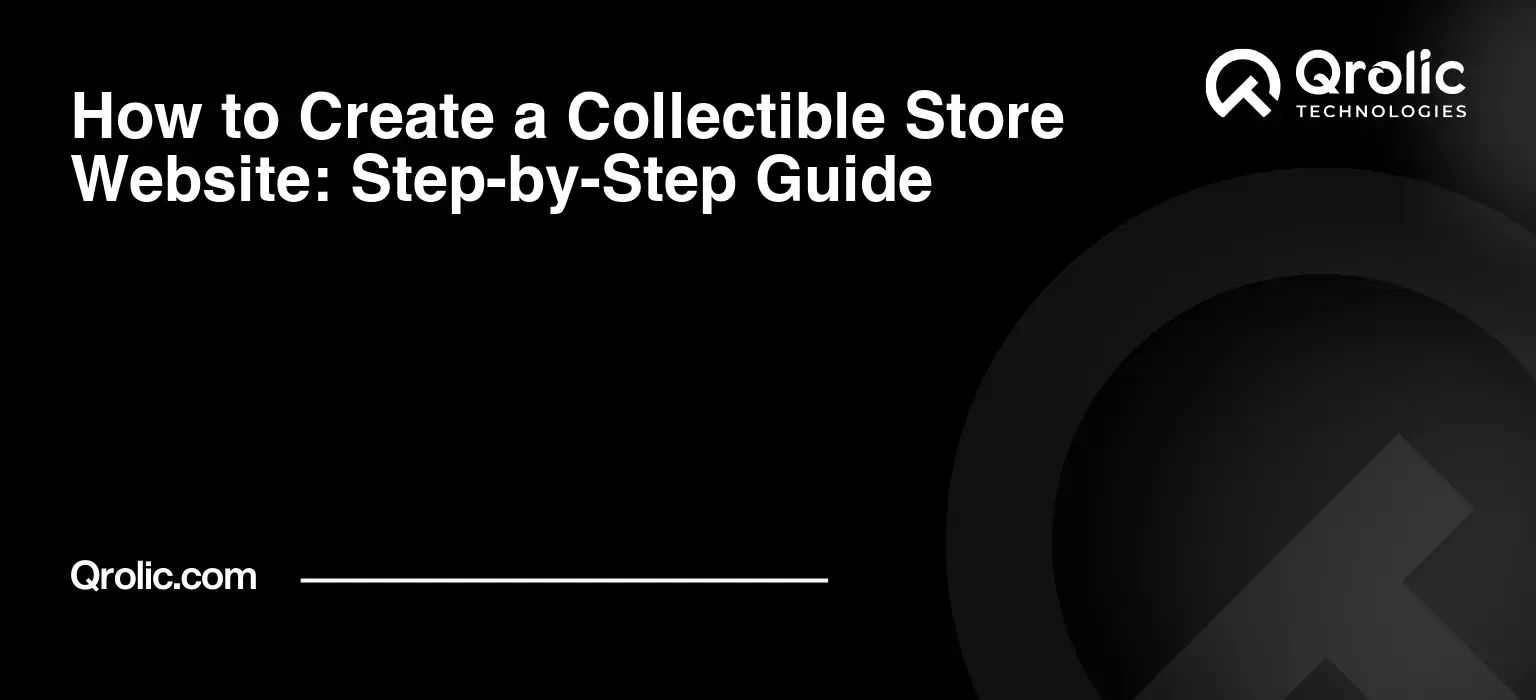Quick Summary:
- Define your niche and pick a strong platform.
- Use high-quality photos and engaging descriptions.
- Drive sales with SEO, social media, and email.
- Always update, analyze data, and offer great service.
Table of Contents
- 1. Laying the Foundation: Planning Your Collectible Store Website
- 1.1 Defining Your Niche and Target Audience: The Heart of Your Collectible Store Website
- 1.2 Choosing the Right Domain Name: Your Online Identity
- 1.3 Selecting a Website Platform: The Foundation of Your Online Store
- 1.4 Setting Up Your Payment Gateway: Getting Paid for Your Treasures
- 1.5 Planning Your Website Structure and Navigation: Creating a User-Friendly Experience
- 2. Designing Your Collectible Store Website: Showcasing Your Treasures
- 2.1 Choosing a Theme or Template: Setting the Visual Tone
- 2.2 Creating High-Quality Product Photos: Capturing the Essence of Your Collectibles
- 2.3 Writing Compelling Product Descriptions: Telling the Story of Your Treasures
- 2.4 Optimizing Your Website for Mobile Devices: Reaching Customers on the Go
- 2.5 Implementing Specialty Retail Design Principles Online: Creating an Engaging Experience
- 3. Marketing Your Collectible Store Website: Driving Traffic and Sales
- 3.1 Search Engine Optimization (SEO): Getting Found on Google
- 3.2 Social Media Marketing: Building a Community of Collectors
- 3.3 Email Marketing: Nurturing Relationships with Your Customers
- 3.4 Paid Advertising: Reaching a Wider Audience
- 4. Maintaining and Growing Your Collectible Store Website
- 4.1 Regularly Updating Your Website: Keeping Things Fresh
- 4.2 Analyzing Your Website Data: Understanding Your Customers
- 4.3 Providing Excellent Customer Service: Building Loyalty
- 4.4 Staying Up-to-Date with Industry Trends: Keeping Your Edge
- 5. Qrolic Technologies: Your Partner in Digital Transformation
1. Laying the Foundation: Planning Your Collectible Store Website
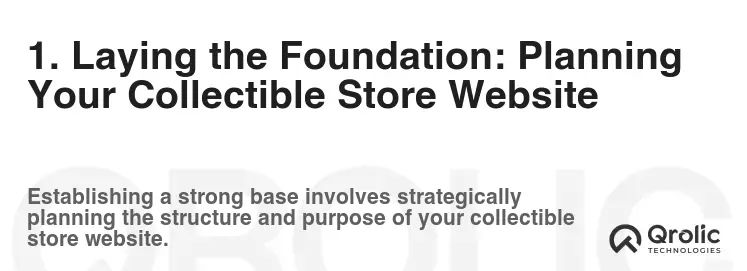
1.1 Defining Your Niche and Target Audience: The Heart of Your Collectible Store Website
Before diving headfirst into website creation, understanding what you’re selling and who you’re selling to is paramount. This isn’t just about saying you sell “collectibles.” It’s about narrowing down your niche.
-
What type of collectibles are you specializing in? Are you focusing on vintage toys, rare coins, sports memorabilia, comic books, trading cards, antique dolls, art prints, or something entirely unique? The narrower your focus, the easier it becomes to attract a dedicated audience.
-
Who is your ideal customer? Understanding their demographics, interests, and spending habits is critical. Are you targeting casual collectors, serious investors, hobbyists, nostalgia seekers, or gift-givers?
Why is this important? Defining your niche allows you to:
- Tailor your product selection: Offer items that specifically appeal to your target audience.
- Create targeted marketing campaigns: Reach the right people with the right message.
- Build a strong brand identity: Position yourself as an expert in your chosen niche.
- Improve SEO: Focus on keywords relevant to your specific collectibles.
How to define your niche and target audience:
- Market research: Analyze existing online marketplaces and forums related to your collectibles. See what people are buying, selling, and discussing.
- Competitor analysis: Identify your competitors and understand their strengths and weaknesses. What are they doing well? Where can you differentiate yourself?
- Customer surveys: If you have existing customers, ask them about their interests, buying habits, and preferences.
- Create buyer personas: Develop detailed profiles of your ideal customers, including their demographics, interests, motivations, and pain points.
Example:
Instead of just selling “collectibles,” you might specialize in “graded Pokemon cards from the 1990s” targeting “adults aged 25-45 who collected Pokemon cards as children and are now looking to recapture their nostalgia.”
This targeted approach allows you to create a website that caters specifically to this audience, increasing your chances of success. This is the first crucial step in any step-by-step guide to creating your collectible store website.
1.2 Choosing the Right Domain Name: Your Online Identity
Your domain name is your online address and should be memorable, relevant, and easy to spell.
What makes a good domain name?
- Relevance: It should reflect your niche and brand. Ideally, it should include keywords related to your collectibles.
- Memorability: It should be easy to remember and pronounce.
- Shortness: Shorter domain names are generally easier to remember and type.
- Availability: Check if the domain name is available in your preferred extension (e.g., .com, .net, .org).
- Brandability: Does it sound professional and trustworthy?
Tips for choosing a domain name:
- Brainstorm keywords: Think of keywords related to your collectibles and niche.
- Use a domain name generator: Tools like Namecheap’s Beast Mode or GoDaddy’s Domain Name Generator can help you generate ideas.
- Check for trademarks: Ensure your chosen domain name doesn’t infringe on existing trademarks.
- Consider using a keyword in your domain name: If possible, include a relevant keyword (e.g., VintageToyStore.com).
- Register multiple extensions: If your primary domain name is available in multiple extensions, consider registering them to protect your brand.
Where to register your domain name:
- GoDaddy
- Namecheap
- Bluehost
- Google Domains
Example:
If you specialize in vintage baseball cards, consider domain names like “VintageBaseballCards.com,” “ClassicCardCollectibles.com,” or “OldTimeBaseballCards.com.”
1.3 Selecting a Website Platform: The Foundation of Your Online Store
Choosing the right website platform is a critical decision. It will determine the functionality, design options, and ease of use of your collectible store website. Several popular options are available, each with its own pros and cons.
Key Considerations:
- Ease of Use: How easy is the platform to learn and use, especially if you have limited technical skills?
- Customization: How much control do you have over the design and functionality of your website?
- E-commerce Features: Does the platform offer the features you need to sell collectibles online, such as shopping carts, payment gateways, and inventory management?
- Scalability: Can the platform handle your growing business as you add more products and customers?
- SEO Friendliness: Is the platform optimized for search engines?
- Pricing: How much does the platform cost per month or year? Are there any transaction fees?
Popular Website Platforms:
- Shopify: A dedicated e-commerce platform known for its ease of use, comprehensive features, and extensive app store. It’s a great option for beginners and experienced online sellers alike.
- Pros: User-friendly, excellent e-commerce features, scalable, good SEO, extensive app store.
- Cons: Can be more expensive than other options, transaction fees apply unless you use Shopify Payments.
- Squarespace: A website builder known for its beautiful templates and ease of use. While not specifically designed for e-commerce, it offers e-commerce features suitable for smaller online stores.
- Pros: Easy to use, visually appealing templates, good customer support.
- Cons: Less e-commerce functionality than Shopify, less customizable.
- WordPress with WooCommerce: A powerful and flexible option that combines the content management capabilities of WordPress with the e-commerce functionality of WooCommerce. It’s a good choice for businesses that need a highly customizable website.
- Pros: Highly customizable, open-source, large community support, SEO-friendly.
- Cons: Can be more complex to set up and manage than Shopify or Squarespace, requires more technical skills.
- Etsy: While technically a marketplace, Etsy can be a good option for starting out, especially if you’re selling handmade or vintage collectibles.
- Pros: Easy to set up, large existing customer base, low initial cost.
- Cons: Less control over branding, high transaction fees, competition from other sellers.
Recommendation:
For most collectible store owners, Shopify is the recommended platform due to its ease of use, comprehensive e-commerce features, and scalability. It’s a solid choice for building a professional and successful online store.
1.4 Setting Up Your Payment Gateway: Getting Paid for Your Treasures
A payment gateway is essential for processing online transactions securely. It acts as the intermediary between your website and your customer’s bank, ensuring that payments are processed safely and efficiently.
Key Considerations:
- Transaction Fees: How much does the payment gateway charge per transaction?
- Security: Is the payment gateway PCI DSS compliant, ensuring the security of your customer’s financial data?
- Payment Options: Does the payment gateway support the payment methods your customers prefer, such as credit cards, debit cards, PayPal, and other popular options?
- Ease of Integration: How easy is it to integrate the payment gateway with your website platform?
- Reputation: Does the payment gateway have a good reputation for reliability and customer service?
Popular Payment Gateways:
- Shopify Payments: Shopify’s own payment gateway, which offers competitive rates and seamless integration.
- PayPal: A widely used payment gateway known for its security and convenience.
- Stripe: A developer-friendly payment gateway that offers a wide range of features and customization options.
- Authorize.net: A popular payment gateway that offers a variety of payment processing solutions.
Setting up your payment gateway:
- Create an account: Sign up for an account with your chosen payment gateway.
- Verify your business: Provide the necessary documentation to verify your business.
- Integrate with your website: Follow the payment gateway’s instructions to integrate it with your website platform.
- Test the integration: Make a test purchase to ensure that the payment gateway is working correctly.
1.5 Planning Your Website Structure and Navigation: Creating a User-Friendly Experience
A well-structured website with clear navigation is essential for providing a positive user experience. Visitors should be able to easily find what they’re looking for, whether it’s a specific collectible or information about your store.
Key Elements of Website Structure:
- Homepage: The first page visitors see. It should provide an overview of your store and highlight your best-selling or most interesting collectibles.
- Category Pages: Organize your collectibles into logical categories, such as “Vintage Toys,” “Rare Coins,” or “Sports Memorabilia.”
- Product Pages: Detailed pages for each individual collectible, including high-quality images, descriptions, and pricing information.
- About Us Page: Tell your story and explain why you’re passionate about collectibles.
- Contact Page: Provide contact information, such as your email address, phone number, and physical address (if applicable).
- FAQ Page: Answer frequently asked questions about your products, shipping, and returns.
- Blog: Share informative and engaging content about collectibles to attract and retain customers.
Tips for creating clear navigation:
- Use a clear and concise menu: The main menu should be visible on every page and should include links to your most important pages.
- Use breadcrumbs: Breadcrumbs show visitors their location on the website and make it easy to navigate back to previous pages.
- Use a search bar: Allow visitors to search for specific collectibles or keywords.
- Use internal links: Link to relevant pages within your website to help visitors discover more content.
- Keep it simple: Avoid overwhelming visitors with too many options or confusing navigation.
2. Designing Your Collectible Store Website: Showcasing Your Treasures
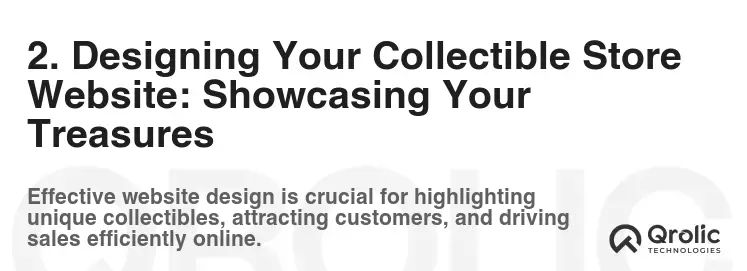
2.1 Choosing a Theme or Template: Setting the Visual Tone
The theme or template you choose will determine the overall look and feel of your website. It’s important to select a theme that is visually appealing, easy to customize, and optimized for e-commerce.
Key Considerations:
- Visual Appeal: Does the theme match your brand and the style of your collectibles?
- E-commerce Features: Does the theme offer the features you need to sell collectibles online, such as product galleries, shopping carts, and checkout pages?
- Customization Options: How much control do you have over the design and layout of the theme?
- Responsiveness: Is the theme responsive, meaning it will look good on all devices, including desktops, tablets, and smartphones?
- SEO Friendliness: Is the theme optimized for search engines?
- Reviews and Ratings: Read reviews from other users to see what they think of the theme.
Where to find themes and templates:
- Shopify Theme Store: Offers a wide selection of premium and free themes designed specifically for Shopify.
- ThemeForest: A marketplace for WordPress themes and website templates.
- TemplateMonster: Another marketplace for website templates and themes.
Tips for choosing a theme:
- Consider your brand: Choose a theme that reflects your brand’s personality and values.
- Focus on product presentation: Select a theme that showcases your collectibles in an appealing way.
- Prioritize usability: Choose a theme that is easy to navigate and use.
- Test the theme: Before committing to a theme, test it on different devices and browsers to ensure it looks good and functions properly.
2.2 Creating High-Quality Product Photos: Capturing the Essence of Your Collectibles
High-quality product photos are essential for selling collectibles online. They allow potential buyers to see the details of your items and assess their condition.
Tips for taking great product photos:
- Use good lighting: Natural light is best, but if you’re shooting indoors, use a softbox or other lighting equipment to avoid harsh shadows.
- Use a clean background: A white or neutral background will help your collectibles stand out.
- Take multiple photos from different angles: Show your collectibles from all sides to give buyers a complete view.
- Focus on details: Take close-up shots of any interesting features or flaws.
- Use a tripod: A tripod will help you keep your camera steady and avoid blurry photos.
- Edit your photos: Use photo editing software to adjust the brightness, contrast, and color of your photos.
- Include photos of packaging: If your collectibles come with original packaging, be sure to include photos of it.
- Show scale: Use a common object, like a coin or ruler, to show the size of your collectibles.
Why are good photos so important? In the world of specialty retail design, your product photography is your store’s window display. It’s the first, and sometimes only, impression you make.
2.3 Writing Compelling Product Descriptions: Telling the Story of Your Treasures
Product descriptions are your opportunity to tell the story of your collectibles and convince potential buyers to make a purchase.
Key Elements of a Good Product Description:
- Accuracy: Provide accurate and detailed information about the collectible, including its condition, dimensions, materials, and provenance (history).
- Benefits: Highlight the benefits of owning the collectible, such as its rarity, historical significance, or aesthetic appeal.
- Storytelling: Tell a story about the collectible to make it more engaging and memorable.
- Keywords: Include relevant keywords to improve your website’s SEO.
- Call to Action: Encourage buyers to add the collectible to their cart or contact you for more information.
Tips for writing compelling product descriptions:
- Know your audience: Tailor your descriptions to the interests and knowledge level of your target audience.
- Use descriptive language: Use vivid and evocative language to bring your collectibles to life.
- Highlight the unique features: Focus on what makes your collectibles special and different from others.
- Address potential concerns: Answer any questions or concerns that buyers might have.
- Proofread carefully: Ensure that your descriptions are free of errors in grammar and spelling.
Example:
Instead of simply saying “Vintage baseball card,” you could write: “This 1952 Topps Mickey Mantle card is a true piece of baseball history. Graded a PSA 6, this card features a vibrant image of the young Mantle and is a must-have for any serious collector. The card shows some minor wear around the edges, which is expected for a card of this age, but the colors are still bright and the image is clear. Add this iconic card to your collection today!”
2.4 Optimizing Your Website for Mobile Devices: Reaching Customers on the Go
More and more people are using mobile devices to browse the internet and shop online. It’s essential that your website is optimized for mobile devices to provide a positive user experience and reach a wider audience.
Key Considerations:
- Responsive Design: Use a responsive theme or template that automatically adjusts to different screen sizes.
- Mobile-Friendly Navigation: Ensure that your website’s navigation is easy to use on mobile devices.
- Fast Loading Speed: Optimize your website’s images and code to ensure that it loads quickly on mobile devices.
- Touch-Friendly Design: Use buttons and links that are easy to tap on a touchscreen.
- Mobile-Friendly Checkout: Make sure the checkout process is simple and easy to complete on a mobile device.
How to test your website’s mobile friendliness:
- Google’s Mobile-Friendly Test: Use Google’s free tool to test your website’s mobile friendliness.
- Test on different devices: Test your website on different mobile devices to see how it looks and functions.
2.5 Implementing Specialty Retail Design Principles Online: Creating an Engaging Experience
Specialty retail design isn’t just for brick-and-mortar stores. You can apply the same principles to your collectible store website to create a more engaging and memorable experience for your customers.
Key Principles of Specialty Retail Design:
- Storytelling: Create a narrative around your brand and your collectibles.
- Visual Merchandising: Use high-quality photos and videos to showcase your collectibles in an appealing way.
- Atmosphere: Create a mood or feeling that reflects your brand and the style of your collectibles.
- Customer Service: Provide excellent customer service to build relationships with your customers.
- Exclusivity: Offer unique or limited-edition collectibles to create a sense of scarcity and value.
Examples of implementing specialty retail design principles online:
- Create a virtual tour of your store (if you have one).
- Host live video auctions or demonstrations.
- Offer personalized recommendations based on customer’s browsing history.
- Create a loyalty program to reward repeat customers.
- Partner with other businesses to offer exclusive promotions.
3. Marketing Your Collectible Store Website: Driving Traffic and Sales
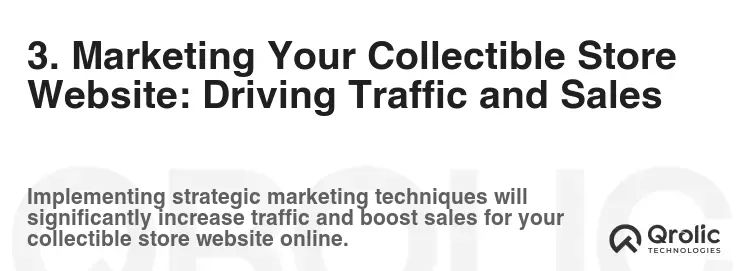
3.1 Search Engine Optimization (SEO): Getting Found on Google
SEO is the process of optimizing your website to rank higher in search engine results pages (SERPs). This is essential for driving organic traffic to your website.
Key SEO Factors:
- Keyword Research: Identify the keywords that your target audience is using to search for collectibles online.
- On-Page Optimization: Optimize your website’s content, meta tags, and URLs with relevant keywords.
- Off-Page Optimization: Build backlinks from other websites to improve your website’s authority.
- Technical SEO: Ensure that your website is technically sound and easy for search engines to crawl and index.
- Content Marketing: Create high-quality content that is informative and engaging.
SEO Tips for Collectible Store Websites:
- Target long-tail keywords: Long-tail keywords are longer and more specific than generic keywords. They often have lower search volume but higher conversion rates. For example, instead of targeting the keyword “baseball cards,” target the long-tail keyword “1952 Topps Mickey Mantle baseball card PSA 6.”
- Use descriptive alt text for your images: Alt text is the text that appears when an image cannot be displayed. Use descriptive alt text to tell search engines what your images are about.
- Create a blog: Share informative and engaging content about collectibles to attract and retain customers.
- Build backlinks from other websites: Reach out to other websites in your niche and ask them to link to your website.
- Use social media to promote your website: Share your website’s content on social media to reach a wider audience.
3.2 Social Media Marketing: Building a Community of Collectors
Social media is a powerful tool for building a community of collectors and driving traffic to your website.
Key Social Media Platforms for Collectible Stores:
- Facebook: A great platform for building a community and sharing updates about your store.
- Instagram: A visually driven platform that is perfect for showcasing your collectibles.
- Twitter: A good platform for sharing news and engaging in conversations with collectors.
- Pinterest: A platform for sharing images and videos of your collectibles.
Social Media Marketing Tips:
- Post regularly: Keep your social media accounts active by posting regularly.
- Share engaging content: Share content that is informative, entertaining, and visually appealing.
- Use hashtags: Use relevant hashtags to reach a wider audience.
- Run contests and giveaways: Contests and giveaways are a great way to attract new followers and generate engagement.
- Interact with your followers: Respond to comments and messages promptly.
3.3 Email Marketing: Nurturing Relationships with Your Customers
Email marketing is a cost-effective way to nurture relationships with your customers and drive sales.
Email Marketing Tips:
- Build an email list: Offer a free gift or discount in exchange for email signups.
- Segment your email list: Segment your email list based on customer interests and purchase history.
- Send targeted emails: Send emails that are relevant to each segment of your email list.
- Use a clear call to action: Make it easy for customers to take the desired action, such as visiting your website or making a purchase.
- Track your results: Track your email open rates, click-through rates, and conversion rates to see what’s working and what’s not.
3.4 Paid Advertising: Reaching a Wider Audience
Paid advertising can be a cost-effective way to reach a wider audience and drive traffic to your website.
Popular Paid Advertising Platforms:
- Google Ads: A platform for running search engine ads and display ads.
- Facebook Ads: A platform for running ads on Facebook and Instagram.
Paid Advertising Tips:
- Target your ads: Target your ads to reach your ideal customers.
- Use compelling ad copy: Write ad copy that is attention-grabbing and relevant to your target audience.
- Use high-quality images: Use high-quality images in your ads to capture the attention of potential customers.
- Track your results: Track your ad performance to see what’s working and what’s not.
4. Maintaining and Growing Your Collectible Store Website
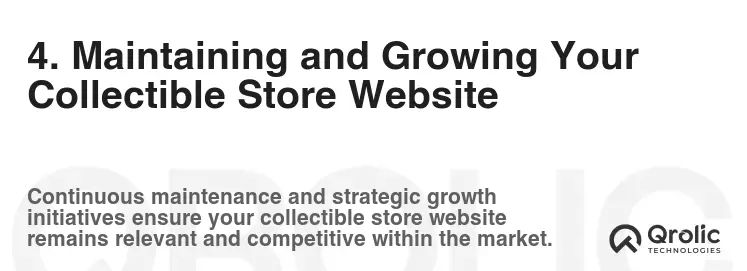
4.1 Regularly Updating Your Website: Keeping Things Fresh
Regularly updating your website is essential for keeping it fresh, engaging, and relevant.
Things to Update Regularly:
- Product Listings: Add new products and update existing product listings.
- Blog Content: Publish new blog posts on a regular basis.
- Website Design: Refresh your website’s design to keep it looking modern and up-to-date.
- Security: Keep your website’s software and plugins up-to-date to protect it from security threats.
4.2 Analyzing Your Website Data: Understanding Your Customers
Analyzing your website data is essential for understanding your customers and improving your website’s performance.
Key Website Metrics to Track:
- Traffic: Track the number of visitors to your website.
- Bounce Rate: Track the percentage of visitors who leave your website after viewing only one page.
- Conversion Rate: Track the percentage of visitors who make a purchase.
- Average Order Value: Track the average amount of money that customers spend per order.
- Customer Acquisition Cost: Track the cost of acquiring a new customer.
Tools for Analyzing Website Data:
- Google Analytics: A free tool for tracking website traffic and user behavior.
- Shopify Analytics: A built-in analytics tool for Shopify stores.
4.3 Providing Excellent Customer Service: Building Loyalty
Providing excellent customer service is essential for building loyalty and generating repeat business.
Tips for Providing Excellent Customer Service:
- Respond to inquiries promptly: Respond to customer inquiries as quickly as possible.
- Be helpful and informative: Provide customers with helpful and informative answers to their questions.
- Be polite and professional: Treat customers with respect and professionalism.
- Resolve issues quickly: Resolve customer issues as quickly as possible.
- Offer a satisfaction guarantee: Offer a satisfaction guarantee to give customers peace of mind.
4.4 Staying Up-to-Date with Industry Trends: Keeping Your Edge
Staying up-to-date with industry trends is essential for keeping your competitive edge.
Ways to Stay Up-to-Date:
- Read industry blogs and publications: Subscribe to industry blogs and publications to stay informed about the latest trends.
- Attend industry events: Attend industry events to network with other professionals and learn about new technologies.
- Follow industry leaders on social media: Follow industry leaders on social media to stay up-to-date on their latest insights.
5. Qrolic Technologies: Your Partner in Digital Transformation
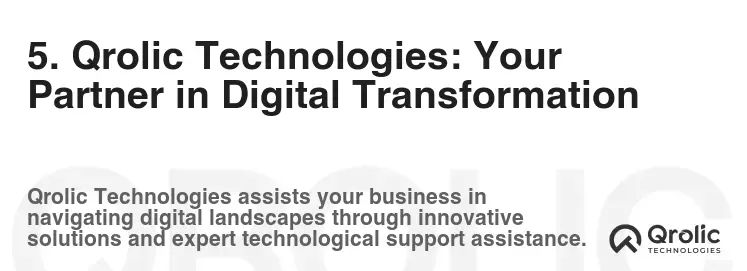
Qrolic Technologies (https://qrolic.com/) is a leading provider of digital transformation services, specializing in website development, e-commerce solutions, and digital marketing. We understand the unique challenges and opportunities of the collectible market and can help you create a collectible store website that is visually appealing, user-friendly, and optimized for search engines.
How Qrolic Technologies Can Help:
- Website Design and Development: We can design and develop a custom website that reflects your brand and showcases your collectibles in the best possible light.
- E-commerce Solutions: We can help you set up a secure and reliable e-commerce platform that allows you to sell your collectibles online with ease.
- Digital Marketing: We can help you develop and implement a digital marketing strategy that drives traffic to your website and generates sales.
- SEO Optimization: We can optimize your website for search engines to help you rank higher in search results.
- Ongoing Support and Maintenance: We provide ongoing support and maintenance to ensure that your website is always running smoothly.
Whether you’re just starting out or looking to take your existing collectible store website to the next level, Qrolic Technologies can help you achieve your goals. Contact us today to learn more about our services. We can assist with the specialty retail design aspects of your online store, ensuring a user experience that mirrors the passion you have for your collectibles.
By following this comprehensive step-by-step guide, and perhaps partnering with experts like Qrolic Technologies, you’ll be well on your way to creating a thriving online presence for your collectible business!
